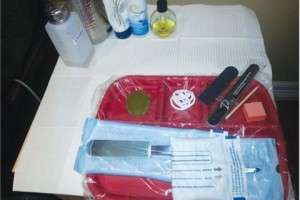Dear Clients
I found a great article written for nail technicians; subject Diabetes. I made all facialists and nail technicians study this article. I think it will be good for you to read, as well. If you frequent spas that do not follow certain sanitation rules, hopefully this article will make you aware of some of the hidden dangers.
Diabetic clients have specific needs and concerns when it comes to nail services, especially pedicures. Below are some of the symptoms of diabetes and what you need to know to take the proper precautions to help your diabetic client enjoy a safe and relaxing service.
POOR CIRCULATION/PERIPHERAL NEUROPATHY: Poor circulation is one of the major complications of diabetes. “High blood sugar levels improperly nourish the nerves in the lower leg arteries, which results in peripheral neuropathy, a type of nerve damage that leads to decreased sensation, especially in the feet,” says Godfrey F. Mix, DPM. Before performing a pedicure on a diabetic client, evaluate her circulation by making sure you can feel the pulse in her feet. They should be warm and have good coloration (not bluish or deep reddish). Other indications of poor circulation are the absence of hair growth on the extremity and thin, fragile skin, with lack of underlying fatty tissue. Next, check for normal feeling by lightly rubbing your fingertip on the bottom of her foot, doing the same on the palm of her hand, and then asking her if she feels a difference in sensation between the two. If so, or if there are indications of extremely poor circulation as outlined above, you should refer her for medical evaluation before performing a service. If she passes your evaluation, perform the pedicure with extreme care. Use only tepid water to soak or simply clean the feet, no hotter than 90 degrees. Some experts contend that soaking the feet may dry them further.
BLOOD CLOTS: According to the American Heart Association, diabetes increases the risk of plaque buildup in the arteries, which can cause dangerous blood clots. Use an extremely gentle massage technique, lightly rubbing the client’s feet and calves to keep the blood moving. Apply gentle, even pressure on the foot, heel, and calf. Because of the possibility of blood clots, Melodie Hand of Tickled Pink Salon and Spa in Clayton, N.C., has a policy of no deep massage of the feet and legs during a diabetic’s client’s pedicure. “Massage runs the risk of throwing (dislodging) blood clots that may be present – either known or unknown – causing further complications for the client,” says Hand. “In addition, due to the possible thinning of the skin, over-manipulation can also cause skin tears.”
THINNING OF THE SKIN: One third of all diabetics will suffer some skin-related condition in their lifetime, according to Dr. Mix. Poor circulation and lack of sensation cause many skin problems. Small blood capillaries in the skin are easily injured by fluctuations in blood sugar levels, and glands in the skin slow or even cease production of natural lubricants. This results in dry, cracked, thin, fragile, and itchy skin that is easily injured, which can lead to severe consequences for a diabetic. In addition to evaluating a client’s circulation before performing a pedicure, you should also check the skin on her feet and calves to make sure there is no broken skin, open cuts, ulcers, wounds, or infections. Never perform a pedicure if there are open cuts or infection. Apply lotion to the top and bottom of the feet only; do not apply between the toes. Moisture between the toes can become trapped, which can lead to infections.
SUSCEPTIBILITY TO INFECTION: Because diabetes reduces the white blood cells’ ability to destroy bacteria, the diabetic cannot fight infections well. “Any minor skin irritation or injury has the potential of becoming a severe, life threatening condition,” says Dr. Mix. Use a disinfectant on the client’s feet before the service. Never cut the client’s cuticles or push them back, the cuticle should remain intact, as it acts as a natural barrier that keeps bacteria from getting under the nail fold. File the toenails to shape them, and if you must trim them, do so carefully. Straight across is best. To reduce the risk of ingrown toenails, cuts, or infections, leave a small free edge. Refer the client to a podiatrist if the corners need to be removed or if you see potential for ingrown nails. When filing the nails, use extreme care, as any abrasion of the skin can cause an opening for infection. (For the same reason, a foot file and sloughing creams should be used very carefully, if at all.) Never use Credo blades, even if they are allowed in your state. Consider providing personal implement kits for your diabetic clients. And last, but most important, practice impeccable sanitation procedures in your salon.
DIABETIC’S RX: Here’s a summary of the basic steps to use in a diabetic pedicure:
- Gather your client’s history and keep a record of it. If she says her blood sugar averages higher than 150 or if she is insulin-dependent, refer her to a podiatrist for foot care.
- Do a physical evaluation of the client. Check the skin, the circulation, and the sensation of the lower extremity.
- If it’s safe to proceed, wash the client’s feet gently with an antibacterial soap and water no hotter than 90 degrees, and then pat dry.
- Shape the nails straight across with a file. Work gently, being especially careful not to abrade the skin.
- Soften cuticles by applying a mild cuticle treatment, but do not trim or push back the cuticles.
- Use a foot file to gently smooth calluses, but only if necessary; thinning skin can lead to susceptibility to infection.
- Apply moisturizer to the top and bottom of the feet, but do not apply between the toes.
- Massage each foot thoroughly using gentle pressure. Apply polish.
Nails Magazine March 2014

